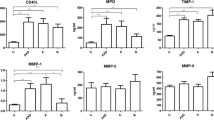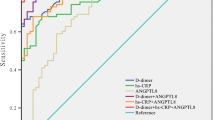Abstract
To evaluate the use of activated protein C–protein C inhibitor (APC-PCI) complex levels for detection of abdominal aortic aneurysm (AAA) in patients with peripheral atherosclerotic disease (PAD). APC-PCI levels and aortic diameter evaluated in 511 PAD patients without previously known AAA followed-up concerning survival for 4.8(0.5) years. AAA was found in 13 % of patients. Aortic diameter correlated (r = 0.138; p = 0.002) with APC-PCI levels which were higher (0.40[0.45] vs. 0.30[0.49] μg/l; p = 0.004) in patients with AAA. This difference persisted in multivariate analysis (p = 0.029). A threshold value of APC-PCI ≥0.15 μg/L showed a specificity of 11 %, a sensitivity of 97 % and a negative predictive value of 96 % for an AAA diagnosis. APC-PCI levels were higher in patients with AAA, and showed high sensitivity but low specificity for the diagnosis and can therefore not be considered as a screening tool in PAD patients. An AAA prevalence of 13 % in patients with PAD indicates a need for AAA screening within this population.

Similar content being viewed by others
References
Schermerhorn ML, Cronenwett JK (2005) Abdominal aortic and iliac aneurysm. Elsevier Saunders, Philadelphia, pp 1408–1452
Svensjö S, Björck M, Gürtelschmid M, Gidlund KD, Hellberg A, Wanhainen A (2011) Low prevalence of abdominal aortic aneurysm among 65-year-old Swedish men indicates a change in the epidemiology of the disease. Circulation 124:1118–1123
Silverberg E, Boring CC, Squires TS (1990) Cancer statistics. CA Cancer J Clin 40:318–319
Boll AP, Severens JL, Verbeek AL, Van der Viliet JA (2003) Mass screening on abdominal aortic aneurysm in men aged 60 to 65 years in The Netherlands. Impact on life expectancy and cost-effectivenesss using a Markov model. Eur J Vasc Endovasc Surg 26:74–80
Ehlers L, Overvad K, Sorensen J, Christensen S (2002) Analysis of cost effectiveness of screening Danish men aged 65 for abdominal aortic aneurysm. BMJ 338:b2243
Ålund M, Mani K, Wanhainen A (2008) Selective screening for abdominal aortic aneurysm among patients referred to the vascular laboratory. Eur J Vasc Endovasc Surg 35:669–674
Barba A, Estallo L, Rodríguez L, Baquer M, Vega de Céniga M (2005) Detection of abdominal aortic aneurysm in patients with peripheral artery disease. Eur J Vasc Endovasc Surg 30:504–508
Moll FL, Powell JT, Fraedrich G, Verzini F, Haulon S, Waltham M et al (2011) Management of abdominal aortic aneurysms clinical practice guidelines of the european society for vascular surgery, european society for vascular surgery. Eur J Vasc Endovasc Surg 41:1–58
Giannitsis E, Siemens HJ, Mitusch R, Tennenborn L, Wiegand U, Schmücker G et al (1999) Prothrombin fragments F1+2, thrombinantithrombin III complexes, fibrin monomers and fibrinogen in patients with coronary atherosclerosis. Int J Cardiol 68:269–274
Meade TW, Mellows S, Brozovic M, Chakrabarti RR, Haines AP, Imeson JD et al (1986) Haemostatic function and ischaemic heart disease: principal results of the Northwick Park Heart Study. Lancet 2:533–537
Cassar K, Bachoo P, Ford I, Greaves M, Brittenden J (2005) Markers of coagulation activation, endothelial stimulation and inflammation in patients with peripheral arterial disease. Eur J Vasc Endovasc Surg 29:171–176
Herren T, Stricker H, Haeberli A, Do DD, Straub PW (1994) Fibrin formation and degradation in patients with arteriosclerotic disease. Circulation 90:2679–2686
Makin AJ, Chung NA, Silverman SH, Lip GH (2003) Thrombogenesis and endothelial damage/dysfunction in peripheral artery disease. Relationship to ethnicity and disease severity. Thromb Res 111:221–226
Kölbel T, Strandberg K, Mattiasson I, Stenflo S, Lindblad B (2006) Activated protein C–protein C inhibitor complex: a new biological marker for aortic aneurysms. J Vasc Surg 43:935–939
Blomstrand D, Kölbel T, Lindblad B, Gottsäter A (2008) Activated protein C–protein C inhibitor complex in peripheral arterial disease. Ann Vasc Surg 24:558–595
Guyton AC, Hall JE (2000) Textbook of medical physiology, 10th edn. Saunders, Philadelphia
Rosenberg RD (1987) The biochemistry and pathophysiology of the prethrombotic state. Annu Rev Med 38:493–508
Strandberg K, Astermark J, Björgell O, Becker C, Nilsson PE, Stenflo J (2001) Complexes between activated protein C and protein C inhibitor measured with a new method: comparison of performance with other markers of hypercoagulability in the diagnosis of deep vein thrombosis. Thromb Haemost 86:1400–1408
Watanabe R, Wada H, Sakakura M, Mor Y, Nakasaki T, Okugawa Y et al (2000) Plasma levels of activated protein C–protein C inhibitor complex in patients with hypercoagulable states. Am J Hematol 65:35–40
Strandberg K, Bhiladvala P, Holm J, Stenflo J (2001) A new method to measure plasma levels of activated protein C in complex with protein C inhibitor in patients with acute coronary syndromes. Blood Coagul Fibrinolysis 12:503–510
Strandberg K, Kjellberg M, Knebel R, Lilja H, Stenflo J (2001) A sensitive immunochemical assay for measuring the concentration of the activated protein C-protein C inhibitor complex in plasma: use of a catcher antibody specific for the complexed/cleaved form of the inhibitor. Thromb Haemost 86:604–610
Kölbel R, Strandberg K, Donath R, Mattiasson I, Stenflo J, Lindblad B (2008) Activated protein C–protein C inhibitor complex in patients with abdominal aortic aneurysms: is it associated with diameter and growth rate? Vasc Endovasc Surg 42:135–140
Bhiladvala P, Strandberg K, Stenflo J, Holm J (2006) Early identification of acute myocardial infarction by activated protein C–protein C inhibitor complex. Thromb Res 118:213–219
Strandberg J, Stenflo J, Nilsson C, Svensson PJ (2005) APC-PCI complex concentration is higher in patients with previous venous thromboembolism with Factor V Leiden. J Thromb Haemost 3:2578–2580
Nilsson P, Berglund G (2000) Prevention of cardiovascular disease and diabetes: lessons from the Malmo Preventive Project. J Intern Med 248:455–462
Strandberg K, Svensson A, Stenflo J (2003) Stabilyte tubes that contain strongly acidic citrate prevent in vitro complex formation between activated protein C and protein C inhibitor. Thromb Haemost 89:947–949
Svensjö S, Björck M, Gürtelschmid M, Djavani K, Gidlund A, Hellberg A, Wanhainen A (2011) Low prevalence of abdominal aortic aneurysm among 65-year-old Swedish men indicates a change in the epidemiology of the disease. Circulation 124:1118–1123
Isselbacher E (2005) Contemporary reviews in cardiovascular medicine thoracic and abdominal aortic aneurysms. Circulation 111:816–828
Buth J, van Marrewijk CJ, Harris PL, Hop WC, Riambau V, Laheij RJ (2002) Outcomes of endovascular abdominal aortic aneurysm repair in patients with conditions considered unfit for an open procedure: a report on the EUROSTAR experience. J Vasc Surg 35:211–221
Kölbel T, Strandberg K, Mattiasson I, Stenflo J, Lindblad B (2006) Activated protein C–protein C inhibitor complex: a new biological marker for aortic aneurysms. J Vasc Surg 43:935–939
Kölbel T, Goncalves I, Dias N, Strandberg K, Acosta A, Gottsäter A (2010) Coagulation activation and ultrasound characteristics in patients with carotid artery disease. Thromb Res 125:171–177
Multicentre Aneurysm Screening Study Group (2002) The Multicentre Aneurysm Screening Study (MASS) into the effect of abdominal aortic aneurysm screening on mortality in men: a randomised controlled trial. Lancet 360:1531–1539
Scott RA, Wilson NM, Ashton HA, Kay DN (1995) Influence of screening on the incidence of ruptured abdominal aortic aneurysm: 5-year results of a randomised controlled study. Br J Surg 82:1066–1070
Lindholt JS, Juul S, Fasting H, Henneberg EW (2005) Screening for abdominal aortic aneurysms: single centre randomised controlled trial. BMJ 330:750
Norman PE, Jamrozik K, Lawrence-Brown MM, Le MT, Spencer CA, Tuohy RJ et al (2004) Population based randomized controlled trial on impact of screening on mortality from abdominal aortic aneurysm. BMJ 329:1259
Kuzmik GA, Sang AX, Elefteriades JA (2012) Natural history of thoracic aortic aneurysms. J Vasc Surg 66:565–571
Gottsäter A, Flondell-Site D, Kölbel T, Lindblad B (2008) Associations between statin treatment and markers of inflammation, vasoconstriction, and coagulation in patients with abdominal aortic aneurysm. Vasc Endovascular Surg 6:567–573
Alhadad A, Wictorsson C, Lindblad B, Gottsäter A (2010) Risk factor control in peripheral arterial disease can be improved. Registry study of secondary prophylactic drug therapy. Lakartidningen 107:2322–2325
Acknowledgments
This study was supported by grants from the Ernhold Lundström Foundation, Research Funds at Skåne University Hospital MAS, the Albert Påhlsson Foundation, the Hulda Ahlmroth Foundation, and from the Swedish Government under the LUA/ALF agreement.
Conflict of interest
None of the authors have any conflicts of interest to disclose.
Author information
Authors and Affiliations
Corresponding author
Rights and permissions
About this article
Cite this article
Zarrouk, M., Keshavarz, K., Lindblad, B. et al. APC-PCI complex levels for screening of AAA in patients with peripheral atherosclerosis. J Thromb Thrombolysis 36, 495–500 (2013). https://doi.org/10.1007/s11239-013-0871-6
Published:
Issue Date:
DOI: https://doi.org/10.1007/s11239-013-0871-6




